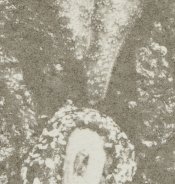In my experience, Fabriano Artistico (both extra white and traditional) is quite stable in that shrinkage is bit less than other papers I use. Remember—papers such as those are 100% cotton and will shrink after becoming wet—just like laundry! The larger the sheet/image you print, the more noticeable the shrinkage will appear. It's just one of many factors to deal with in gum printing.
Paper sized by the manufacturer with AKD (such as Fabriano) are my first choice of papers for gum printing. AKD (in essence an emulsified wax) migrates into the paper and forms a bond that is difficult to remove even after repeated soaking and washing—so don't worry about losing your AKD sizing when presoaking the paper. Yes, the surface of the paper will become just a bit rougher as a result. If that is a major concern to you, then adding supplemental size to recreate a smooth surface might need to be considered. Supplemental size would also be a consideration if you require a very broad range of pigment choices.
Otherwise, simply locate pigments which will not stain the paper if you wish to have images with contrast and definition. Of course, that may take a bit of leg work on your part—but not any more than the leg work required to learn and manage supplemental sizing techniques, especially those mentioned in previous posts. I think you will find AKD papers will provide you with a larger selection of non-staining pigments than papers sized by the manufacturer with other materials.
Hope that helps.
Paper sized by the manufacturer with AKD (such as Fabriano) are my first choice of papers for gum printing. AKD (in essence an emulsified wax) migrates into the paper and forms a bond that is difficult to remove even after repeated soaking and washing—so don't worry about losing your AKD sizing when presoaking the paper. Yes, the surface of the paper will become just a bit rougher as a result. If that is a major concern to you, then adding supplemental size to recreate a smooth surface might need to be considered. Supplemental size would also be a consideration if you require a very broad range of pigment choices.
Otherwise, simply locate pigments which will not stain the paper if you wish to have images with contrast and definition. Of course, that may take a bit of leg work on your part—but not any more than the leg work required to learn and manage supplemental sizing techniques, especially those mentioned in previous posts. I think you will find AKD papers will provide you with a larger selection of non-staining pigments than papers sized by the manufacturer with other materials.
Hope that helps.
Last edited by a moderator:


 )
) 
